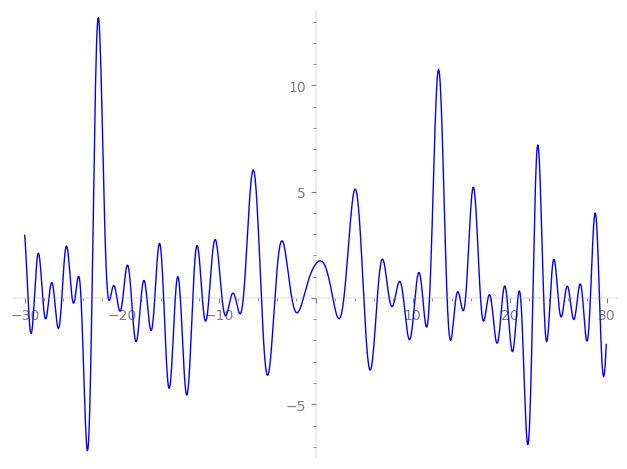| L(s) = 1 | + (−1.87 − 0.695i)2-s + 2.63·3-s + (3.03 + 2.60i)4-s + (1.21 − 4.84i)5-s + (−4.93 − 1.83i)6-s + 12.3·7-s + (−3.86 − 7.00i)8-s − 2.07·9-s + (−5.65 + 8.24i)10-s − 3.31i·11-s + (7.97 + 6.86i)12-s + 4.53i·13-s + (−23.1 − 8.57i)14-s + (3.19 − 12.7i)15-s + (2.38 + 15.8i)16-s − 12.6i·17-s + ⋯ |
| L(s) = 1 | + (−0.937 − 0.347i)2-s + 0.877·3-s + (0.757 + 0.652i)4-s + (0.243 − 0.969i)5-s + (−0.822 − 0.305i)6-s + 1.76·7-s + (−0.483 − 0.875i)8-s − 0.230·9-s + (−0.565 + 0.824i)10-s − 0.301i·11-s + (0.664 + 0.572i)12-s + 0.348i·13-s + (−1.65 − 0.612i)14-s + (0.213 − 0.850i)15-s + (0.148 + 0.988i)16-s − 0.743i·17-s + ⋯ |
\[\begin{aligned}\Lambda(s)=\mathstrut & 220 ^{s/2} \, \Gamma_{\C}(s) \, L(s)\cr =\mathstrut & (0.576 + 0.817i)\, \overline{\Lambda}(3-s) \end{aligned}\]
\[\begin{aligned}\Lambda(s)=\mathstrut & 220 ^{s/2} \, \Gamma_{\C}(s+1) \, L(s)\cr =\mathstrut & (0.576 + 0.817i)\, \overline{\Lambda}(1-s) \end{aligned}\]
Particular Values
| \(L(\frac{3}{2})\) |
\(\approx\) |
\(1.41649 - 0.734151i\) |
| \(L(\frac12)\) |
\(\approx\) |
\(1.41649 - 0.734151i\) |
| \(L(2)\) |
|
not available |
| \(L(1)\) |
|
not available |
\(L(s) = \displaystyle \prod_{p} F_p(p^{-s})^{-1} \)
| $p$ | $F_p(T)$ |
|---|
| bad | 2 | \( 1 + (1.87 + 0.695i)T \) |
| 5 | \( 1 + (-1.21 + 4.84i)T \) |
| 11 | \( 1 + 3.31iT \) |
| good | 3 | \( 1 - 2.63T + 9T^{2} \) |
| 7 | \( 1 - 12.3T + 49T^{2} \) |
| 13 | \( 1 - 4.53iT - 169T^{2} \) |
| 17 | \( 1 + 12.6iT - 289T^{2} \) |
| 19 | \( 1 - 16.3iT - 361T^{2} \) |
| 23 | \( 1 - 11.8T + 529T^{2} \) |
| 29 | \( 1 - 27.7T + 841T^{2} \) |
| 31 | \( 1 + 2.38iT - 961T^{2} \) |
| 37 | \( 1 + 59.7iT - 1.36e3T^{2} \) |
| 41 | \( 1 - 16.4T + 1.68e3T^{2} \) |
| 43 | \( 1 - 48.6T + 1.84e3T^{2} \) |
| 47 | \( 1 + 80.3T + 2.20e3T^{2} \) |
| 53 | \( 1 - 66.9iT - 2.80e3T^{2} \) |
| 59 | \( 1 + 12.4iT - 3.48e3T^{2} \) |
| 61 | \( 1 - 2.82T + 3.72e3T^{2} \) |
| 67 | \( 1 + 55.3T + 4.48e3T^{2} \) |
| 71 | \( 1 - 124. iT - 5.04e3T^{2} \) |
| 73 | \( 1 - 130. iT - 5.32e3T^{2} \) |
| 79 | \( 1 - 74.9iT - 6.24e3T^{2} \) |
| 83 | \( 1 + 19.8T + 6.88e3T^{2} \) |
| 89 | \( 1 + 92.5T + 7.92e3T^{2} \) |
| 97 | \( 1 + 7.08iT - 9.40e3T^{2} \) |
| show more | |
| show less | |
\(L(s) = \displaystyle\prod_p \ \prod_{j=1}^{2} (1 - \alpha_{j,p}\, p^{-s})^{-1}\)
Imaginary part of the first few zeros on the critical line
−11.68884201420830437427792934078, −11.00608473617459989221731570367, −9.663209709908985293508156173757, −8.769937262996127643977472304444, −8.279648577283083786432174722192, −7.46467458883417343856846397351, −5.60003846777681001577598712376, −4.20430384077510015780314664774, −2.46490673691694847423223026287, −1.26791456804200072949288383056,
1.76185448991163079234863425396, 2.90477869513623429678774404880, 4.95859062572622645962873469272, 6.34829767630540095400050984363, 7.57285131094840103869292542205, 8.178690782210350203428099739442, 9.033954753042422253310475951776, 10.23732909001893593135666989978, 11.03389146404549251602436589076, 11.73073500445808141253820032245

